-
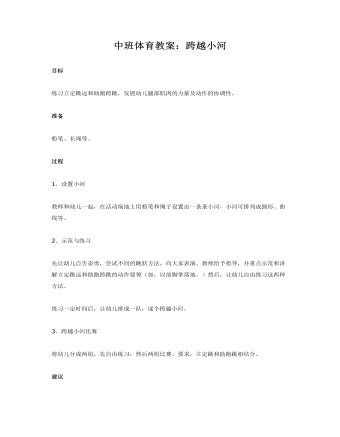
中班体育教案:跨越小河
准备粉笔、长绳等。过程1.设置小河教师和幼儿一起,在活动场地上用粉笔和绳子设置出一条条小河,小河可排列成圆形、曲线等。2.示范与练习先让幼儿自告奋勇,尝试不同的跳跃方法,向大家表演。教师给予指导,并重点示范和讲解立定跳远和助跑跨跳的动作要领(如,以前脚掌落地。)然后,让幼儿自由练习这两种方法。
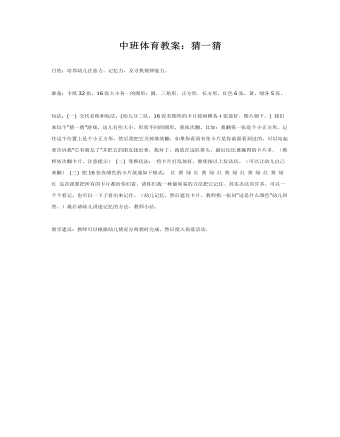
中班体育教案:猜一猜
玩法:(一) 交代名称和玩法:(幼儿分二队,16张有图形的卡片按纵横各4张放好。图片朝下。) 我们来玩个“猜一猜”游戏,这儿有些大小、形状不同的图形,我依次翻,比如:我翻第一张是个小正方形,记住这个位置上是个小正方形,然后我把它关掉继续翻,如果你看到有张卡片是你前面看到过的,可以站起来告诉我“它有朋友了”并把它的朋友找出来,找对了,就放在这队排头,最后比比谁赢得的卡片多。(教师依次翻卡片,注意提示)
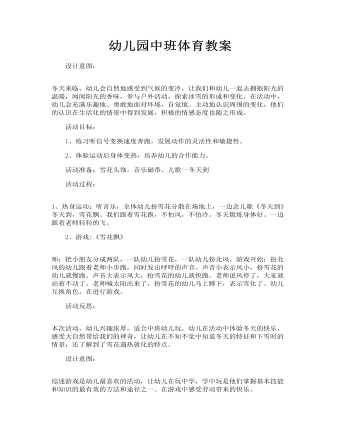
幼儿园中班体育教案
活动目标: 1、练习听信号变换速度奔跑,发展动作的灵活性和敏捷性。 2、体验运动后身体变热,培养幼儿的合作能力。 活动准备:雪花头饰。音乐磁带、儿歌--冬天到 活动过程: 1、热身运动:听音乐,全体幼儿扮雪花分散在场地上,一边念儿歌《冬天到》冬天到,雪花飘。我们跟着雪花跑,不怕风,不怕冷。冬天锻炼身体好。一边跟着老师轻轻的飞。
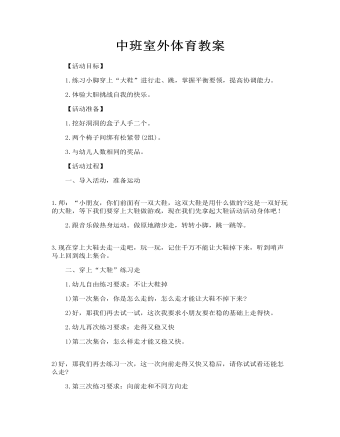
中班室外体育教案
一、导入活动,准备运动 1.师:“小朋友,你们前面有一双大鞋,这双大鞋是用什么做的?这是一双好玩的大鞋,等下我们要穿上大鞋做游戏,现在我们先拿起大鞋活动活动身体吧! 2.跟音乐做热身运动。做原地踏步走,转转小脚,跳一跳等。 3.现在穿上大鞋去走一走吧,玩一玩,记住千万不能让大鞋掉下来,听到哨声马上回到线上集合。 二、穿上“大鞋”练习走 1.幼儿自由练习要求:不让大鞋掉 1)第一次集合,你是怎么走的,怎么走才能让大鞋不掉下来? 2)好,那我们再去试一试,这次我要求小朋友要在稳的基础上走得快。 2.幼儿再次练习要求:走得又稳又快
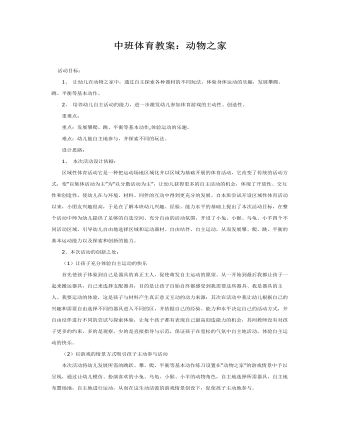
中班体育教案:动物之家
2、 培养幼儿自主活动的能力,进一步激发幼儿参加体育游戏的主动性、创造性。 重难点: 重点:发展攀爬、跳、平衡等基本动作,体验运动的乐趣。 难点:幼儿能自主地参与,并探索不同的玩法。 设计思路: 1、 本次活动设计依据: 区域性体育活动它是一种把运动场地区域化并以区域为基础开展的体育活动,它改变了传统的活动方式,变“以集体活动为主”为“以分散活动为主”,让幼儿获得更多的自主活动的机会,体现了开放性、交互性和创造性,使幼儿在与环境、材料、同伴的互动中得到更充分的发展。自本班尝试开设区域性体育活动以来,小朋友兴趣很高,于是在了解本班幼儿兴趣、经验、能力水平的基础上提出了本次活动目标,在整个活动中师为幼儿提供了足够的自选空间、充分自由的活动氛围,开设了小兔、小猴、乌龟、小羊四个不同活动区域,引导幼儿自由地选择区域和运动器材、自由结伴、自主运动,从而发展攀、爬、跳、平衡的基本运动能力以及探索和创新的能力。

中班体育教案:安全小卫士
2、初步建立自我保护意识。准备:1、课件;2、实物:鞭炮、气球3、录音机、图片、方向盘过程:1、导入活动,激发兴趣。 今天,大班哥哥姐姐到我们这来玩,看!他们在干什么? (大班幼儿表演放鞭炮不小心炸伤手的事情) 老师问:大班哥哥姐姐这样做安全吗?为什么?我们能不能这样做?
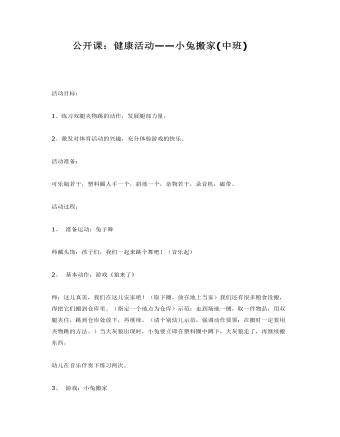
中班体育教案:小兔搬家
2、激发对体育活动的兴趣,充分体验游戏的快乐。活动准备:可乐瓶若干,塑料圈人手一个,斜坡一个,杂物若干,录音机,磁带。活动过程:1、 准备运动:兔子舞师戴头饰:孩子们,我们一起来跳个舞吧!(音乐起)2、 基本动作:游戏《狼来了》师:这儿真美,我们在这儿安家吧!(取下圈,放在地上当家)我们还有很多粮食没搬,得把它们搬到仓库里。(指定一个地点为仓库)示范:走到场地一侧,取一件物品,用双腿夹住,跳到仓库处放下,再继续。(请个别幼儿示范,强调动作要领:在搬时一定要用夹物跳的方法。)当大灰狼出现时,小兔要立即在塑料圈中蹲下,大灰狼走了,再继续搬东西。
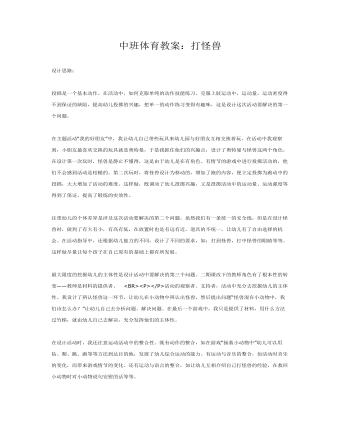
中班体育教案:打怪兽
在主题活动“我的好朋友”中,我让幼儿自己带些玩具来幼儿园与好朋友互相交换着玩,在活动中我观察到,小朋友最喜欢交换的玩具就是奥特曼,于是我抓住他们的兴趣点,设计了奥特曼与怪兽这两个角色。在设计第一次玩时,怪兽是静止不懂得,这是由于幼儿是在有角色、有情节的游戏中进行投掷活动的,他们不会感到活动是枯糙的。第二次玩时,将怪兽设计为移动的,增加了跑的内容,便立定投掷为跑动中的投掷,大大增加了活动的难度。这样做,既调动了幼儿投掷兴趣,又是投掷活动中的运动量、运动强度等得到了保证,提高了锻炼的实效性。注重幼儿的个体差异是涉及这次活动要解决的第二个问题。虽然我们有一条统一的安全线,但是在设计怪兽时,做到了有大有小,有高有低,在放置时也是有远有近。道具的不统一,让幼儿有了自由选择的机会。在活动指导中,还根据幼儿能力的不同,设计了不同的要求,如:打到怪兽,打中怪兽的眼睛等等。这样做尽量让每个孩子在自己原有的基础上都有所发展。最大限度的挖掘幼儿的主体性是设计活动中要解决的第三个问题。二期课改下的教师角色有了根本性的转变——教师是材料的提供者、 <BR><P></P>活动的观察者、支持者,活动中充分去挖掘幼儿的主体性。我设计了辨认怪兽这一环节,让幼儿在小动物中辨认出怪兽,然后提出问题“怪兽混在小动物中,我们该怎么办?”让幼儿自己去分析问题、解决问题。在最后一个游戏中,我只是提供了材料,用什么方法过竹梯,就由幼儿自己去解决,充分发挥他们的主体性。
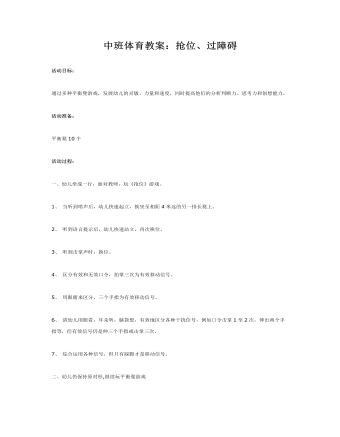
中班体育教案:抢位、过障碍
活动准备:平衡凳10个活动过程:一、幼儿坐成一行,面对教师,玩《抢位》游戏。1、当听到哨声后,幼儿快速起立,换坐至相距4米远的另一排长凳上。2、听到语言提示后,幼儿快速站立,再次换位。3、听到击掌声时,换位。
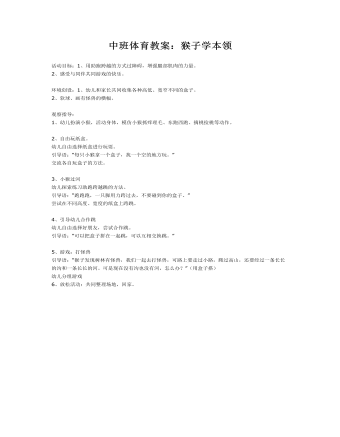
中班体育教案:猴子学本领
环境创设:1、幼儿和家长共同收集各种高低、宽窄不同的盒子。 2、软球、画有怪兽的横幅。 观察指导: 1、幼儿扮演小猴,活动身体,模仿小猴抓痒理毛、东跑西跑、摘桃捡桃等动作。 2、自由玩纸盒。 幼儿自由选择纸盒进行玩耍。 引导语:“每只小猴拿一个盒子,找一个空的地方玩。” 交流各自玩盒子的方法。 3、小猴过河 幼儿探索练习助跑跨越跳的方法。 引导语:“跑跑跑,一只脚用力跨过去,不要碰到你的盒子。” 尝试在不同高度、宽度的纸盒上跨跳。
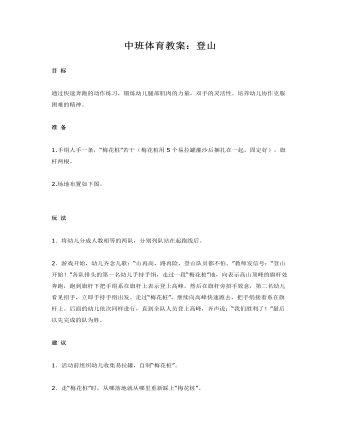
中班体育教案:登山
准备 1.手绢人手一条,“梅花桩”若干(梅花桩用5个易拉罐灌沙后捆扎在一起,固定好)。旗杆两根。 2.场地布置如下图。 玩法 1.将幼儿分成人数相等的两队,分别列队站在起跑线后。
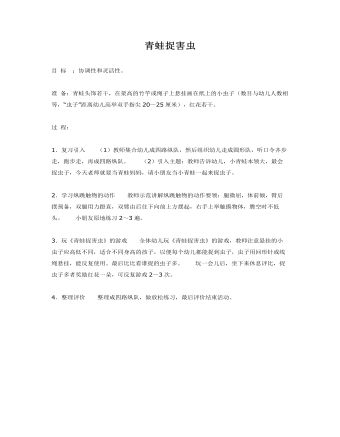
中班体育教案:青蛙捉害虫
过程: 1.复习引入 (1)教师集合幼儿成四路纵队,然后组织幼儿走成圆形队,听口令齐步走,跑步走,再成四路纵队。 (2)引入主题:教师告诉幼儿,小青蛙本领大,最会捉虫子,今天老师就要当青蛙妈妈,请小朋友当小青蛙一起来捉虫子。 2.学习纵跳触物的动作 教师示范讲解纵跳触物的动作要领:腿微屈,体前倾,臂后摆预备,双腿用力蹬直,双臂由后往下向前上方摆起,右手上举触摸物体,腾空时不低头。 小朋友原地练习2~3遍。
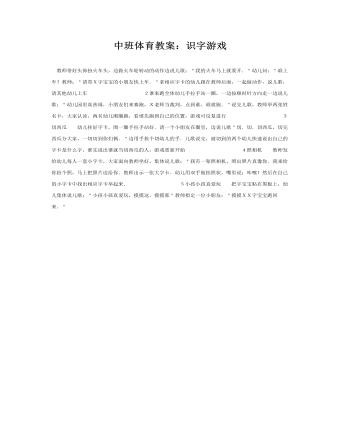
中班体育教案:识字游戏
教师:"请带X字宝宝的小朋友快上车."拿相应字卡的幼儿跟在教师后面,一起做动作,说儿歌,请其他幼儿上车 2谁来跑全体幼儿手拉手站一圈,一边按顺时针方向走一边说儿歌:"幼儿园里真热闹,小朋友们来赛跑,X老师当裁判,点到谁,谁就跑."说完儿歌,教师举两张姓名卡,大家认读,两名幼儿顺圈跑,看谁先跑到自己的位置,游戏可反复进行 3
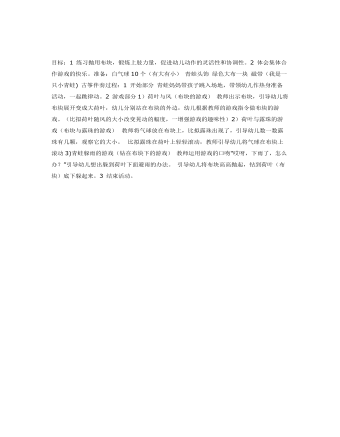
中班体育教案:青蛙戏水
准备:白气球10个(有大有小)青蛙头饰绿色大布一块磁带(我是一只小青蛙) 古筝伴奏过程:1 开始部分青蛙妈妈带孩子跳入场地,带领幼儿作热身准备活动,一起跳律动。2 游戏部分1)荷叶与风(布块的游戏)教师出示布块,引导幼儿将布块展开变成大荷叶,幼儿分别站在布块的外边,幼儿根据教师的游戏指令做布块的游戏。(比拟荷叶随风的大小改变晃动的幅度,一增强游戏的趣味性)

中班体育游戏教案:熊来了
活动准备:“熊”头饰一只,圈划幼儿活动范围和“熊家”活动过程: 1、导入活动。 教师:“如果你突然遇到一头大狗熊,你该怎么样,它才不会吃你?” 幼儿讨论提出意见。 2、设置情境,观察讨论熊的习性。 (1)请另一位老师扮成熊,听到主 班 老师说“哎呀!瞧,我们班来了一只大狗熊!你们快用你刚才的办法试试看,看它会不会吃你!”就出现。 幼儿尝试自己的办法,熊将出声的,动的幼儿抓走。 教师请没被抓走的幼儿介绍自己的方法:没有动,没有出声音等。

中班心理健康教案
二、活动目标: 1、在游戏中认识日常生活中高兴和生气的表情。 2、学习用语言表达感受,用适当的方式表达自己的情绪。 3、体验关爱、亲情、共享的快乐。 三、 重点与难点: 正确认知自己的情绪,学习合理疏泄、控制自己的情绪。 四、活动准备: 红星娃娃、高兴和生气的表情娃娃、高兴娃娃和生气娃娃的家、情景卡片、水彩笔、记号笔、制作表情娃娃的纸
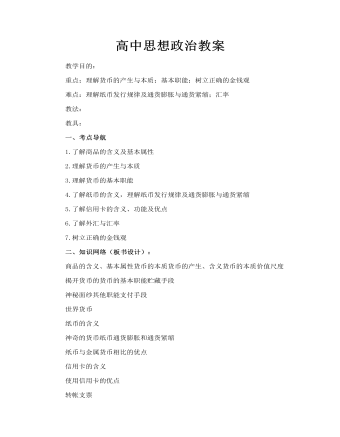
高中思想政治教案
一、考点导航 1.了解商品的含义及基本属性 2.理解货币的产生与本质 3.理解货币的基本职能 4.了解纸币的含义,理解纸币发行规律及通货膨胀与通货紧缩 5.了解信用卡的含义、功能及优点 6.了解外汇与汇率 7.树立正确的金钱观
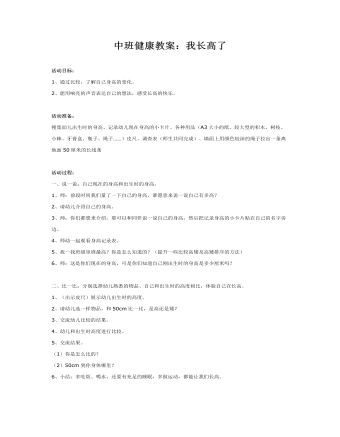
中班健康教案:我长高了
活动准备:搜集幼儿出生时的身高、记录幼儿现在身高的小卡片、各种用品(A3大小的纸、较大型的积木、树枝、小棒、牙膏盒、瓶子、绳子……)皮尺、调查表(师生共同完成)、墙面上用颜色较深的绳子拉出一条离地面50厘米的长线条 活动过程:一、说一说:自己现在的身高和出生时的身高。1、师:前段时间我们量了一下自己的身高,谁愿意来说一说自己有多高?2、请幼儿介绍自己的身高。3、师:你们都想来介绍,那可以和同伴说一说自己的身高,然后把记录身高的小卡片贴在自己的名字旁边。4、师幼一起观看身高记录表。5、找一找班级里谁最高?你是怎么知道的?(提升一些比较高矮及高矮排序的方法)6、师:这是你们现在的身高,可是你们知道自己刚出生时的身高是多少厘米吗?
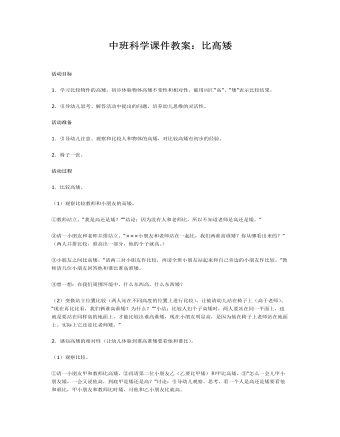
中班科学课件教案:比高矮
2.引导幼儿思考、解答活动中提出的问题,培养幼儿思维的灵活性。活动准备1.引导幼儿注意、观察和比较人和物体的高矮,对比较高矮有初步的经验。2.椅子一张。活动过程1.比较高矮。(1)观察比较教师和小朋友的高矮。①教师站立。“我是高还是矮?”“结论:因为没有人和老师比,所以不知道老师是高还是矮。”②请一小朋友和老师并排站立。“×××小朋友和老师站在一起比,我们两谁高谁矮?你从哪看出来的?”(两人并排比较,谁高出一部分,他的个子就高。)
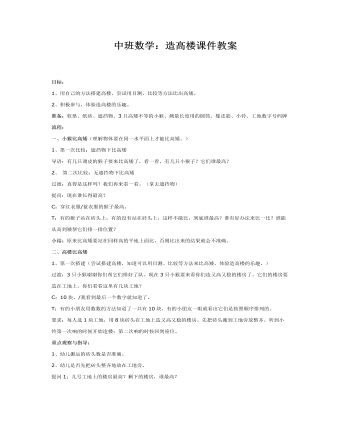
中班数学:造高楼课件教案
2、积极参与,体验造高楼的乐趣。准备:软垫、纸砖、遮挡物、3只高矮不等的小猴、测量长度用的圆筒、橡皮筋、小铃、工地数字号码牌流程:一、小猴比高矮(理解物体要在同一水平面上才能比高矮。) 1、第一次比较:遮挡物下比高矮 导语:有几只调皮的猴子要来比高矮了,看一看,有几只小猴子?它们谁最高? 2、第二次比较:无遮挡物下比高矮 过渡:真得是这样吗?我们再来看一看。(拿去遮挡物) 提问:现在谁长得最高? C:穿红衣服/蓝衣服的猴子最高。 T:有的猴子站在砖头上,有的没有站在砖头上,这样不能比。到底谁最高?谁有好办法来比一比?谁能从高到矮帮它们排一排位置? 小结:原来比高矮要站在同样高的平地上面比,否则比出来的结果就会不准确。





















